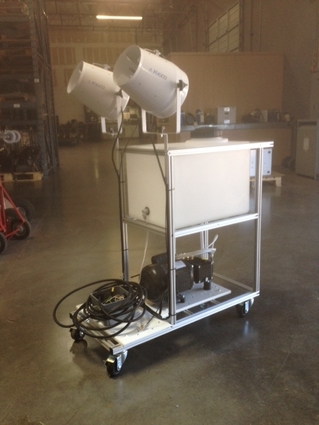 Industry Standards for Pest Control Marijuana Venture Magazine - September 2015 Anyone who has been cultivating for more than a year or two has experienced the challenges associated with pest control, and they are both unpleasant and unavoidable, especially in a large-scale setting. The standard list of cannabis predators includes powdery mildew, aphids, mites, gnats, white flies, and thrips, with powdery mildew and mites being the most difficult to permanently eradicate. Even though mildew isn’t an insect, it still falls under the rubric of “pest control” because it’s a living organism that attacks and destroys cannabis. Pests enter a grow room in one of three ways- through openings in the building, on the skin, hair and clothing of workers and visitors, and on plants brought in from other locations. In this sense, taking steps to prevent these various kinds of breaches is the first and most important part of maintaining a pest-free environment. Standard prevention techniques include the following:
With the right prevention steps being taken, the frequency of infestations will dramatically drop, but will probably still happen from time to time. This is why cultivation sites must be prepared for pest treatment by utilizing the right kinds of equipment and supplies once preventative measures have failed. If you’ve seen many indoor commercial cultivation spaces, you will have noticed the modular build-out design that has become standard. Grow sites are subdivided into individual rooms that range in size from 200 to 2000 sq. ft. Besides allowing for more targeted and efficient environmental controls, these subdivisions make pest problems more containable and treatable when they happen. Once a problem has been identified, the room is shut off from the rest of the site while a special crew addresses the problem, and this increases the chances that the problem can be controlled quickly without spreading to other areas. In most cases, infestations are treated with sprays of some kind, and going into the details of all the various sprays and insect types is a much larger discussion than can be covered in this article. What’s most important is that the spray is applied properly, and that means using atomizers, also sometimes referred to as foggers. Atomizers reduce the micron size of liquid particles to the point where the room is literally being humidified rather than just merely sprayed. This ensures absolute coverage of all the plant surfaces. Complete coverage is further augmented by the use of a surfactant in the spray mixture that keeps water particles from beading up, much the way detergent works in a clothes washing machine. Many growers will claim that certain sprays have failed at handling a pest problem when, in fact, the application method has been the problem. With an atomizer and a surfactant, variables are eliminated from the equation, such that the substances being used for treatment can be assessed for what they are. Some sprays act on contact with the plants, whereas others take some time to have an effect. Those that act on contact are often best washed off quickly after being applied in order to minimize potential damage to the tissue of the plants, that many sprays are known to cause. Additionally, floors and work surfaces should be washed shortly after the treatment application in order to minimize worker exposure to harmful residues, which is often the riskiest aspect of pest control for commercial grow operations. Workers should wear protective outerwear and gloves both during and after the treatment process to minimize contact with any sprays that could have health consequences when used in concentrated quantities. No grower can live a life without pests, but taking comprehensive steps towards prevention and using reliable treatment systems can certainly minimize the pain and suffering that comes along with the territory.
1 Comment
|
AuthorJennifer is a monthly columnist for Marijuana Venture and SF Evergreen Magazines and owns/operates the product review website and blog WeedGear.com. She writes on beginner and advanced cannabis cultivation topics, entrepreneurship, trends & technologies, and DIY cannabis crafts. Here are some recent articles. ArchivesCategories |
 RSS Feed
RSS Feed